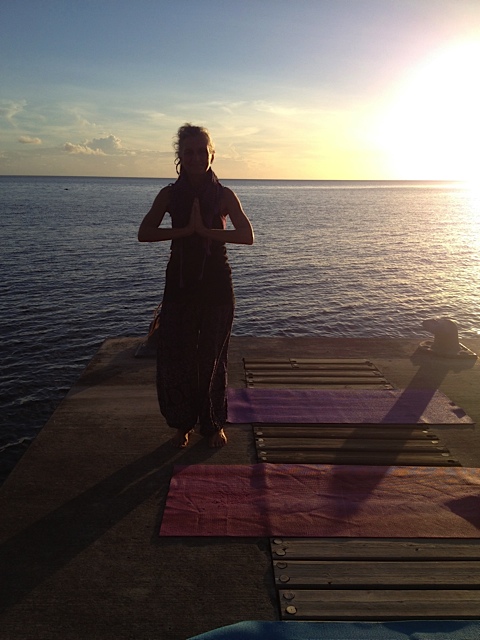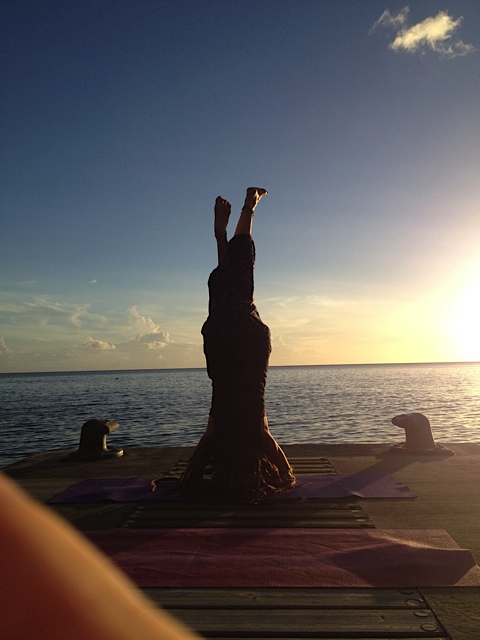Definition of Mindfulness noun
I don’t remember hearing the word Mindfulness or Mindful much in the 1970’s when I first started studying yoga. But the word does so aptly describe the focus of the mind in all aspects of yoga practice: mindful movement; mindful breathing; mindful meditating; mindful socializing; mindful eating; mindful livity.
Archa my teacher was the first teacher I had who really took you inside the body as you practiced. When I came out of her classes – I would often remark to myself how the class was like a holiday from the daily chatter of my mind.
My mind has always been FILLED with daily chatter from the moment I woke up till the moment I slept. Yoga taught me I could control that; I could focus on the moment. I could actually decide to enjoy each moment more; I could actually decide whether that thought that was going round and round in my mind was beneficial to me.
For me it was the Mindful Movements that helped me go within at first; then the Breath Control Techniques and then the Mindful Meditation Techniques.
Mindfulness is one of the side effects of Practicing Yoga no matter what style no matter what technique.
What is Mindfulness?
That is one of our topics of study during our Yoga Teacher Training. To give you a taste of the information we will be sharing I copied and pasted our document on ‘The Mindfulness of Yoga’ from our Training Manual ‘The Spectrum of Yoga’; Chapter: The Techniques of Yoga” below:
Quote “The path of yoga requires faith, energy, mindfulness, meditation and wisdom. ~ Pantjali; Yoga Sutras 1.20
NAME: THE MINDFULNESS OF YOGA
Sanskrit: Smṛti / स्मृति)
Other Names: Zen
At Rainbow Yoga promoting The Mindfulness of Yoga is one of the most important goals of our Rainbow Yoga Wellness Program. The Mindfulness of Yoga is interwoven into almost all the paths and practices. Knowing how to be mindful/conscious and in the moment is one of the most basic of our life skills. When we are not conscious we do not enjoy life to the fullest.
We encourage students to bring The Mindfulness of Yoga into their day to day life outside the studio as well as we deeply believe this results in a more holistic, healthy life and is a another step towards achieving oneness with the absolute.
The Mindfulness of Yoga teaches students to recognize and then control negative or stressful thought patterns. It teaches us to pause; realize our first reaction is often one of limited perspective; look at the bigger more holistic picture and then make some intentional choices on what to do.
We trust once The Mindfulness of Yoga has been experienced in class through a variety of techniques – it will gradually flow into other areas of daily life.
Definition
At Rainbow Yoga Health and Wellness we consider ‘mindfulness’ to be a ‘state of being’; a ‘multidimensional consciousness’ – a state of active, observant attention to the present.
Our sensations. thoughts and feelings are observed from a distance, without judging them good or bad as we maneuver through our day to day life. The ramifications of our actions are considered before we act; with each decision we strive to enhance our prana/energy levels.
Mindfulness is a training of the mind to be more aware of what we are doing; it differs from deep sleep or relaxation or even deep meditation in that it involves active mental effort rather than total rest, release or surrender. Through mindfulness we can gain new perspectives on life. The practice of yoga refines this awareness through a variety of practices such as concentrating on the fine tuning and alignment of the postures; the subtlety of the breath; the focal point in balances, the ramifications of conscious living and turning the consciousness inward (pratyahara). From there the practice moves to increasingly subtler forms of mindfulness such as one-pointedness (dharana) to one-flowingness (dhyana) to absorption (samadhi).
You will often find one tiny concept of the yoga lifestyle extolled as the only way to reach mindfulness but it is the wide range of techniques that makes yoga so effective.
Note: Not to confuse The Mindfulness of Yoga (state of mind) with The Mindful Meditations of Yoga (techniques to assist with a ‘mindful’ ‘state of mind/being’).
History
The Mindfulness of Yoga predates most mindfulness programs of today and most of the techniques utilized to reach a ‘mindful’ ‘state of being’ are yoga based. The general populace looks on mindfulness as deriving from Buddhism yet the first yoga carvings predate Buddhism by 1000’s of years.
The Mindfulness of Yoga can be used beneficially to alter or build healthy patterns of living; enhance overall health and increase cognitive function.
Present Day
Recently a scientific program designed by John Kabat Zahn based on Buddhist mindfulness meditation traditions and various techniques used in yoga named Mindfulness Based Stress Reduction MBSR has become very popular. There are many people who use the terms Mindfulness Based Stress Reduction and Mindfulness interchangeably. MBSR is more accurately one of many programs incorporating a few of The Mindful Meditation Techniques of Yoga with a few of The Mindful Breaths and Breath Movements of Yoga and a few of The Mindful Movements and Postures of Yoga to promote health and wellness.
In Psychiatry mindfulness is being used to treat a host of mental challenges within the fields of Positive Psychology and Cognitive Therapy.
In Neurology ‘mindfulness’ has been broken down into various terms of sense: “proprioception” – refers to the awareness of ‘one’s own body’ and its muscular, tendon, and articular movements; and the awareness of the positioning of the body parts in relationship to each other’; “introspection” – ; refers to the awareness of ‘one’s own internal messages; “exteroception” – refers to the process by which Extroceptors (organs which process information outside of body, such as the eyes, ears, mouth, and skin) send information to the brain; “interoception” – refers to the process by which interoceptors (organs which process informaton inside of the body (such as taste buds) send information to the brain, (Charles Sharington, 2007).
Benefits
Practicing The Mindfulness of Yoga can help people to begin to recognize their habitual patterns of mind; movement and ways of living that develop over time and then respond in a new rather than habitual way.
When you consider the ramifications if everyone in the world utilized mindfulness in their daily life – mindfulness can help with almost every situation and every condition we meet as individuals; communities and organizations – the world would be a better place.
Traditional
Traditionally the ultimate goal of mindfulness was absorption/oneness/unity with the absolute.
The Benefits
The benefits of ‘Mindfulness’ are so many it would be hard to list them all. Literally every aspect of our lives can benefit from mindfulness; our physical health; our mental health; our energetic health and those around us benefit too. Our communities our earth
Studies
Over the past 20 years there has been a plethora of studies on the health benefits of the practice of ‘MBSR or other Mindfulness Techniques’. Studies have shown ‘mindfulness’ to be helpful in the treatment of Post Traumatic Stress; Depression; Obesity; Schizophrenia; Eating Disorders; Stress Management; Heart Disease; Stroke; Diabetes; Metabolic Syndrome. Studies have shown The Mindful Lifestyle of Yoga can: enhance The Immune System at a cellular level; build brain function and memory; reverse Heart Disease; change Prostrate Cancer cells at a cellular level.
During our Rainbow Yoga Teacher Training Programme we share the studies we have gathered for a lifetime.
Note:
Teacher Tips:
Rainbow Yoga encourages the development of The Mindfulness of Yoga through the practice of The Mindful Movements and Positions of Yoga; The Mindful Breaths of Yoga; The Mindful Breath Movements of Yoga; The Mindful Meditations of Yoga; and The Mindful Living of Yoga.
As Rainbow Yoga Teachers we encourage participants to experience The Mindfulness of Yoga through: The Flow of Yoga; The Mind Body Breath Connection; Body Honesty; Verbal Cues; Visual Cues and Mindful Business Practices.
As participants start to tune into themselves this can facilitate emotional release. As Rainbow Yoga Teachers we are supportive; non-judgmental and accepting guiding our students to approach a professional if the emotions extend from trauma.
As Rainbow Yoga Teachers we start every class with the concept of mindfulness and refresh everyone’s memory and intention of mindfulness repeatedly as the class goes on. Remind each class to carry their mindfulness into their daily life.
Opening classes with the Progressive Muscle Relaxation is a great way to promote mindfulness of the body.
After the students become more aware of the body from within bring the awareness to the breath through a Breath Observation or a Mindful Breath Technique of Yoga. Observing the breath from within is one of the basic mindfulness skills in almost every practice.
After the class has found the breath and the body encourage them to find the Mind, Body, Breath Connection to promote their mindfulness by executing a few movements that Warm Up the body in coordination with the breath and move it in most of the main directions.
Verbal Cues, Visual Cues, Imagery Cues and Kinesthetic Cues are invaluable for the promotion of mindfulness throughout class especially when purposely blending them to address all Learning Styles.
A clean healthy soothing Environment and a safe protective supportive Atmosphere is essential for students to feel secure enough to be able to let everything go and focus on the moment.
At Rainbow Yoga the concept of The Mindfulness of Yoga is incorporated in every program we teach from Cooking Workshops to Hatha Yoga Classes.
We are constantly adding to our programme to keep our clients interested and stimulated – ‘mindful’.
The Business of Teaching Yoga
The Mindfulness of Yoga is incorporated in every program we teach at Rainbow Yoga from Health and Wellness Vacations to Hiking Tours; Cooking Workshops and Hatha Yoga and Meditation Classes.
At Rainbow Yoga we strive to bring The Mindfulness of Yoga into our own daily lives and business operations – whether designing and teaching our programmes; when managing our day to day operations; when working with our associates and clients no matter what their status.
Bibliography
Dictionary definitions.
http://www.thefreedictionary.com/mindful
http://en.wiktionary.org/wiki/mindfulness
Wikipedia State of Flow
http://en.wikipedia.org/wiki/Flow_(psychology)
Wikipedia Mindfulness in Buddhism
http://en.wikipedia.org/wiki/Mindfulness
Wikipedia Mindfulness in Psychology
http://en.wikipedia.org/wiki/Mindfulness_(psychology)
Wikipedia Proprioception
http://en.wikipedia.org/wiki/Proprioception
Wikipedia Introspection
http://en.wikipedia.org/wiki/Introspection
Wikipedia Mindfulness Based Stress Release
http://en.wikipedia.org/wiki/MBSR
Yoga Concept of Mindfulness Meditation
http://www.swamij.com/mindfulnessconcentration.htm
Mindfulness – About.com
http://ptsd.about.com/od/glossary/g/Mind_def.htm
Further Research
Books
Online
Centre for Mindfulness; University of Massachusetts
http://www.umassmed.edu/cfm/stress/index.aspx
Mindfulness Information Website
http://www.mindfulnet.org/
Mindful Awareness Research Centre; UCLA
http://marc.ucla.edu/default.cfm
Ted Flow for Happiness
http://www.ted.com/talks/mihaly_csikszentmihalyi_on_flow.html
Cultivate the Seeds of Mindfulness
http://www.yogajournal.com/wisdom/1667
The Neuroscience of Mindfulness
http://www.huffingtonpost.com/david-rock/the-neuroscience-of-mindf_b_2908665.html
Autonomic Nervous System
http://www.mashpedia.com/videoplayer.php?q=jIz4uVnZo0M
Dr. Mihalv Csikszentmihalyi Calaremont University
http://www.cgu.edu/pages/4751.asp
Mihalv Csikszentmihalyi TED bio
http://www.ted.com/speakers/mihaly_csikszentmihalyi
flow the psychology of optimal experience; Mihalv Csikszentmihalyi
http://www.integralvision.net.au/share-it-hub/flow_the_psychology_of_optimal_experience.pdf
blog post on book flow and yoga
http://hathayoga.com/flow-by-mihaly-csikszentmihalyi/

